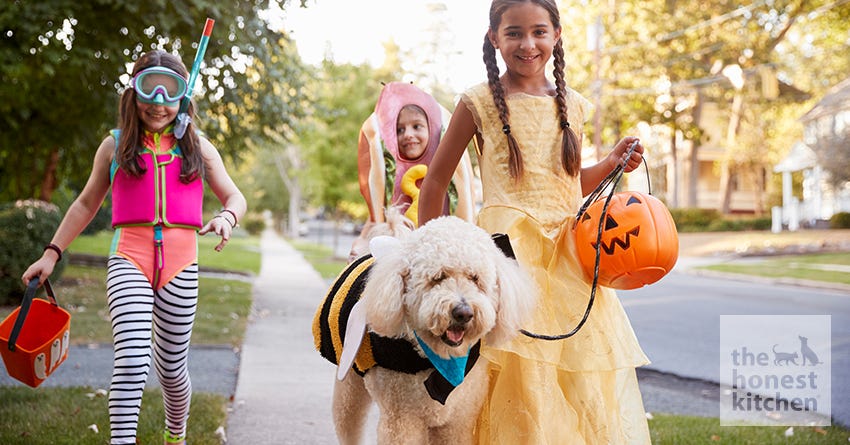Safety Tips for Taking Your Dog Trick-or-Treating

It’s a dilemma faced by many families: Leave your dog at home or take your dog trick-or-treating with the kiddos.
The constant ringing of the doorbell can be stressful for many pooches, but so can the relentless approach to strangers’ homes, in addition to perplexing (to a dog) costumes and crowds of people on the street. It’s not unusual for dogs to panic and bolt, or become aggressive if a costumed child or another dog (also in costume or not) approaches them. How’s a human parent to know? Know your dog. Here are some things to help you make the right decision and keep your dog safe.Your Dog's Age
Age alone isn’t a good determining factor—some young pups are much more resilient to strangeness than older ones, but sometimes older dogs with Halloween experience are completely fine with all the activity. Many are not. Gauge your dog's experience with past Halloweens when making the decision to go out or not.Your Dog's Temperament
If your dog is the anxious nervous type, has a health issue, is very old, or gets particularly squirrelly around other dogs, it’s best to leave him at home. The kindest thing you can do is place your dog in a quiet, low-lit room in a crate or on his bed, perhaps with a television or radio on, as far from the doorbell as possible—even better if your dog can hang out with another family member. If your dog is easy-going, fairly oblivious to other dogs or unmoved by high levels of excitement? By all means, take him along!Costume or Not?
If you do want to dress your pup up for trick-or-treating, make sure it doesn’t restrict his ability to breathe, see, hear, move, or bark. Avoid costumes that constrict anywhere around his nose, neck or body. Be especially wary of rubber bands or safety pins as they can cut into his skin and cause injury. If your dog really doesn’t like the costume, do something simpler: a big orange bow, or Halloween bandana. If you decide to take your dog out with the kiddos, make sure to protect your pet:- Even if your dog is costumed, keep a collar and identification tag with current information on his (even if he's microchipped).
- Keep your dog on a short web-style (not retractable) leash!
- Be mindful of fire hazards. Keep your dog away from candles or lit pumpkins without lids.
- Avoid walking him up long passages with loud, scary music or scenes on display. Have someone stay at the curb with him if you want to approach the situation.
- If you see your dog chewing on something, check immediately to make sure it isn’t an unsafe item such as chocolate, a candy wrapper (which cause intestinal distress and blockage) or gum containing Xylitol, which is highly toxic to dogs. Tell children not to share any food or candy with your dog.
- Pick up a small dog and carry him when you approach a home or are walking among crowded streets or in large groups.
- Worth mentioning twice: keep all dogs on a short leash. Don’t ever let them wander or walk unleashed on Halloween. Dark streets and cars are serious hazards for dogs, kids, and adults.
- Try to bring a friend, older sibling, or grandparent to help you keep an eye on small children and your dog. It can be difficult to manage them all in a chaotic, exciting environment.
- Carry dog treats to reward good behavior, and help desensitize your dog to scary costumes, haunted house decorations, or crowds. Watch for stressful reactions and be prepared to head home.
- Do not accept doggie treats from people you don’t know. Whether it’s a food allergy or something you can’t trace back to a particular source, you don’t want your dog getting sick. Kindly say “no thanks” to the person offering it.
- Make sure you use some type of reflective gear, including LED lighting or luminescent tape to keep your dog seen by other people. You do not want anyone stepping on your tiny dog or on the feet of a larger dog. Lighting will also be useful in keeping your dog visible in the event he or she gets stressed and bolts away from you. Better yet, if traveling with small children and a dog, go out before sundown.


